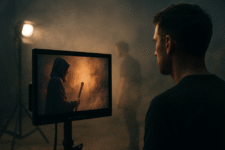
There was a time when volumetric effects were concealed from everyone on a film stage except the VFX supervisors huddled around grainy, low-resolution preview monitors. You could shoot a complex scene with enveloping fog swirled through ancient forests, crackling embers danced in haunted corridors, and ethereal magic wove around a sorcerer’s staff. Yet no one on set saw a single wisp until post-production.
The production crew watched inert surroundings, and actors delivered performances against blank gray walls, tasked with imagining drifting dust motes or seething smoke. All of that changed when real-time volumetrics emerged from research labs into production studios, lifting the veil on atmospheres that breathe and respond to the camera’s gaze as scenes unfold. Today’s filmmakers can sculpt and refine atmospheric depths during the shoot itself, rewriting how cinematic worlds are built and how narratives take shape in front of—and within—the lens.
In those traditional workflows, directors relied on their instincts and memory, conjuring visions of smoky haze or crackling fire in their minds as cameras rolled. Low-resolution proxies (lo-fi particle tests and simplified geometric volumes) stood in for the final effects, and only after long nights in render farms would the full volumetric textures appear.
Actors performed against darkened LED walls or green screens, squinting at pale glows or abstract silhouettes, their illusions tethered to technical diagrams instead of the tangible atmospheres they would inhabit on film. After production wrapped, render farms labored for hours or days to produce high-resolution volumetric scans of smoke swirling around moving objects, fire embers reacting to winds, or magical flares trailing a hero’s gesture. These overnight processes introduced dangerous lags in feedback loops, locking down creative choices and leaving little room for spontaneity.
Studios like Disney pioneered LED Stagecraft for The Mandalorian, blending live LED walls with pre-recorded volumetric simulations to hint at immersive environments. Even ILMxLAB’s state-of-the-art LED volume chambers relied on approximations, causing directors to second-guess creative decisions until final composites arrived.
When real-time volumetric ray-marching demos by NVIDIA stole the spotlight at GDC, it wasn’t just a technical showcase, it was a revelation that volumetric lighting, smoke, and particles could live inside a game engine viewport rather than hidden behind render-farm walls. Unreal Engine’s built-in volumetric cloud and fog systems further proved that these effects could stream at cinematic fidelity without crunching overnight budgets. Suddenly, when an actor breathes out and watches a wisp of mist curl around their face, the performance transforms. Directors pinch the air, asking for denser fog or brighter embers, with feedback delivered instantly. Cinematographers and VFX artists, once separated by departmental walls, now work side by side on a single, living canvas, sculpting light and particle behavior like playwrights improvising on opening night.
Yet most studios still cling to offline-first infrastructures designed for a world of patient, frame-by-frame renders. Billions of data points from uncompressed volumetric captures rain down on storage arrays, inflating budgets and burning cycles. Hardware bottlenecks stall creative iteration as teams wait hours (or even days) for simulations to converge. Meanwhile, cloud invoices balloon as terabytes shuffle back and forth, costs often explored too late in a production’s lifecycle.
In many respects, this marks the denouement for siloed hierarchies. Real-time engines have proven that the line between performance and post is no longer a wall but a gradient. You can see how this innovation in real-time rendering and simulation works during the presentation Real-Time Live at SIGGRAPH 2024. This exemplifies how real-time engines are enabling more interactive and immediate post-production processes. Teams accustomed to handing off a locked-down sequence to the next department now collaborate on the same shared canvas, akin to a stage play where fog rolls in sync with a character’s gasp, and a visual effect pulses at the actor’s heartbeat, all choreographed on the spot.
Volumetrics are more than atmospheric decoration; they constitute a new cinematic language. A fine haze can mirror a character’s doubt, thickening in moments of crisis, while glowing motes might scatter like fading memories, pulsing in time with a haunting score. Microsoft’s experiments in live volumetric capture for VR narratives demonstrate how environments can branch and respond to user actions, suggesting that cinema too can shed its fixed nature and become a responsive experience, where the world itself participates in storytelling.
Behind every stalled volumetric shot lies a cultural inertia as formidable as any technical limitation. Teams trained on batch-rendered pipelines are often wary of change, holding onto familiar schedules and milestone-driven approvals. Yet, each day spent in locked-down workflows is a day of lost creative possibility. The next generation of storytellers expects real-time feedback loops, seamless viewport fidelity, and playgrounds for experimentation, tools they already use in gaming and interactive media.
Studios unwilling to modernize risk more than just inefficiency; they risk losing talent. We already see the impact, as Young artists, steeped in Unity, Unreal Engine, and AI-augmented workflows, view render farms and noodle-shredding software as relics. As Disney+ blockbusters continue to showcase LED volume stages, those who refuse to adapt will find their offer letters left unopened. The conversation shifts from “Can we do this?” to “Why aren’t we doing this?”, and the studios that answer best will shape the next decade of visual storytelling.
Amid this landscape of creative longing and technical bottlenecks, a wave of emerging real-time volumetric platforms began to reshape expectations. They offered GPU-accelerated playback of volumetric caches, on-the-fly compression algorithms that reduced data footprints by orders of magnitude, and plugins that integrated seamlessly with existing digital content creation tools. They embraced AI-driven simulation guides that predicted fluid and particle behavior, sparing artists from manual keyframe labor. Crucially, they provided intuitive interfaces that treated volumetrics as an organic component of the art direction process, rather than a specialized post-production task.
Studios can now sculpt atmospheric effects in concert with their narrative beats, adjusting parameters in real time without leaving the editing suite. In parallel, networked collaboration spaces emerged, enabling distributed teams to co-author volumetric scenes as if they were pages in a shared script. These innovations are the sign of departure from legacy constraints, blurring the line between pre-production, principal photography, and postproduction sprints.
While these platforms answered immediate pain points, they also pointed toward a broader vision of content creation where volumetrics live natively within real-time engines at cinematic fidelity. The most forward-thinking studios recognized that deploying real-time volumetrics required more than software upgrades: it demanded cultural shifts. They see that real-time volumetrics represent more than a tech breakthrough, they bring a redefinition of cinematic storytelling.
When on-set atmospheres become dynamic partners in performance, narratives gain depth and nuance that were once unattainable. Creative teams unlock new possibilities for improvisation, collaboration, and emotional resonance, guided by the living language of volumetric elements that respond to intention and discovery. Yet realizing this potential will require studios to confront the hidden costs of their offline-first past: data burdens, workflow silos, and the risk of losing the next generation of artists.
The path forward lies in weaving real-time volumetrics into the fabric of production practice, aligning tools, talent, and culture toward a unified vision. It is an invitation to rethink our industry, to dissolve barriers between idea and image, and to embrace an era where every frame pulses with possibilities that emerge at the moment, authored by both human creativity and real-time technology.
The post How Real-Time Volumetrics Are Rewriting Film Narratives appeared first on Unite.AI.



